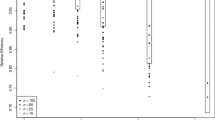Abstract
Researchers apply scan statistics to test for unusually large clusters of events within a time window of specified length w, or alternatively an unusually small window w that contains a specified number of events. In some cases, the researcher is interested in testing for a range of specified window lengths, or a set of several specified number of events k (cluster sizes). In this paper, we derive accurate approximations for the joint distributions of scan statistics for a range of values of w, or of k, that can be used to set an experiment-wide level of significance that takes into account the multiple comparisons involved. We use these methods to compare different ways of choosing the window sizes for the different cluster sizes. One special case is a multiple comparison procedure based on a generalized likelihood ratio test (GLRT) for a range of window sizes. We compare the power of the GLRT with another method for allocating the window sizes. We find that the GLRT is sensitive for very small window sizes at the expense of moderate and larger window sizes. We illustrate these results on two examples, one involving clustering of translocation breakpoints in DNA, and the other involving disease clusters.
Similar content being viewed by others
References
N. Balakrishnan and M. V. Koutras, Runs and Scans with Applications, Wiley: New York, 2002.
D. C. Clark, “Esophageal atresia and tracheosophageal fistula,” American Family Physician Feb 15, p. 919, 1999.
J. Glaz and N. Balakrishnan (eds.), Scan Statistics and Applications, Birkhauser: Boston, 1999.
J. Glaz, J. Naus, and S. Wallenstein, Scan Statistics, Springer-Verlag: New York, 2001.
G. Knox, “Secular pattern of congenital oesophageal atresia,” British Journal of Preventive Social Medicine vol. 13 pp. 222–226, 1959.
M. Kulldorff and N. Nagarwalla, “Spatial disease clusters. Detection and inference,” Statistics in Medicine vol. 14 pp. 799–810, 1995.
C. Loader, “Large deviation approximations to distribution of scan statistics,” Advances in Applied Probability vol. 23 pp. 751–771, 1991.
N. Nagarwalla, “A scan statistic with a variable window,” Statistics in Medicine vol. 15 pp. 845–850, 1996.
N. Neff and J. Naus, Selected Tables in Mathematical Statistics, Vol. VI: The Distribution of the Size of the Maximum Cluster of Points on a Line, American Mathematical Society: Providence, RI, 1980.
M. R. Segal and J. L. Wiemels, “Clustering of translocation breakpoints,” J. American Statistical Association vol. 97 pp. 66–76, 2002.
S. Wallenstein and N. Neff, “An approximation for the distribution of the scan statistic,” Statistics in Medicine vol. 6 pp. 197–207, 1987.
E. H. Wolf, Test for Randomness on the Line and a Related k-sample Test for Homogeneity, Ph.D. Thesis, Rutgers University: New Brunswick, NJ, 1968.
Author information
Authors and Affiliations
Rights and permissions
About this article
Cite this article
Naus, J.I., Wallenstein, S. Multiple Window and Cluster Size Scan Procedures. Methodology and Computing in Applied Probability 6, 389–400 (2004). https://doi.org/10.1023/B:MCAP.0000045087.33227.8c
Issue Date:
DOI: https://doi.org/10.1023/B:MCAP.0000045087.33227.8c



